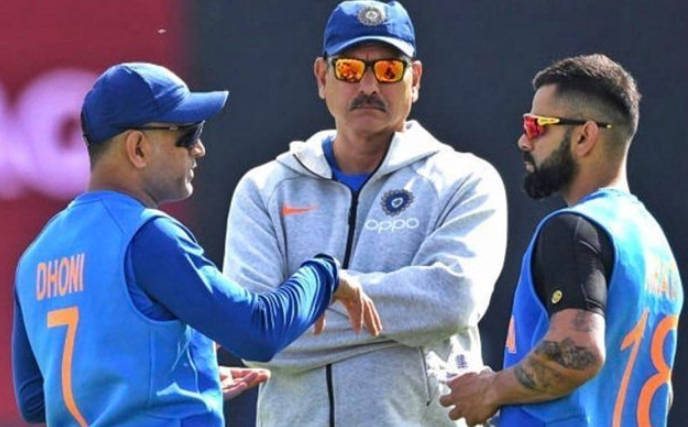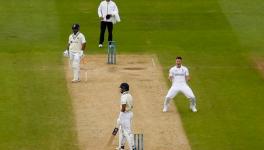The Inevitable Loss That Hit Indian Cricket Team at ICC World Cup Semis | On the Ball

While MS Dhoni’s retirement in inevitable, time could also be up for Ravi Shastri, whose almost four-year stint at the helm of the Indian cricket team (as Director from 2014 to ’16 and coach from 2017) has seen the side lose twice in ICC World Cup semis.
When does an ICC World Cup campaign slip into the category of a failure? When do the post-mortems and recriminations, the name-calling and finger-pointing, begin? When does the clamour for heads gather momentum?
Virat Kohli’s Indian cricket team mounted a stellar campaign at the 2019 World Cup, but had little to show for their exploits during a stirring run in the round-robin phase that netted them seven excellent victories in eight completed matches. Their top-dog status at the end of the league stage, though, counted for little going into the knockout semifinal; they were punished for their first top-order meltdown in nine matches, crashing out to an under-rated but supremely skilled New Zealand outfit despite a spectacular late charge by the tempestuous Ravindra Jadeja.
It didn’t take long for the knives to be unsheathed, for the swords to be drawn from the scabbards, for the hunt for scapegoats to begin. Kohli’s ordinary run in World Cup semifinals – he made 9 in 2011, 1 in 2015 and the same score this time around – was bandied about. The lack of content, if not intent, of the middle-order came under scrutiny. The approach of MS Dhoni, the one-time poster boy who is now the favourite whipping boy, whipped up controversy, if not anger. And the think-tank’s decision to hold him back until No. 7 following the tumble of early wickets and despite the relative inexperience of the middle-order was both castigated and pilloried.
Also Read | MS Dhoni, Chris Gayle and the ‘Old’ Tradition: ICC World Cup Swansongs
Defeated India most certainly were, but they were not disgraced. Not with Jadeja going down all guns blazing, not with Dhoni using all his experience and his nous, his acumen and his starts, to take the team to within 18 of New Zealand’s 239 in tricky conditions superbly exploited by Trent Boult and Matt Henry. New Zealand won the semifinal more than India lost it, however reluctant India’s predominantly fickle ‘fans’ might be to accept it. But it wasn’t at the semifinal stage that India were beaten; long before that, they had sold themselves short with their indecisiveness and their constant chopping and changing in a staggeringly steadfast reluctance to allow people to settle down and grow into their roles.
The proposed meeting next week involving the Committee of Administrators (CoA), and Kohli and head coach Ravi Shastri will break all viewership records were it to be televised live, though one is not sure what point the honourable members of the CoA are trying to drive home through this exercise. It’s neither in their ambit nor in their expertise to try and dissect the team’s performances. Reports have suggested that the overlooking of Ambati Rayudu and Dhoni’s batting position in the semifinal might figure prominently in those discussions.
One can only hope those reports are exaggerated. Questions need to be asked of Kohli, and of Shastri, of India’s scrappy, inconsistent, inexplicably unsettled build-up to the competition. But through the systematic humiliation of the group tasked initially with such exercises – the Cricket Advisory Committee’s brief included, among other things, analyzing the past and planning for the future – Indian cricket has taken two steps backward for every attempted step forward.
Had India carried their extraordinary form of the league phase to the knockouts and gone all the way to their third World Cup, the cracks would have been papered over. It would have been conveniently forgotten that Rayudu, who played the most at No. 4 in the last two years – and with excellent returns except until those three failures against Australia that hurtled him out of contention – was jettisoned without proper explanation.
Video | ISL, I-League, or Bust. Who Cares About the Football? (420 Grams)
It would have swept under the carpet the under-utilisation of Jadeja, the quintessential three-dimensional cricketer whose limited-overs credentials could only have been overlooked by the short-sighted. It would have masked the optimism with which KL Rahul was factored in at No. 4 even though he had played a mere four One-Day Internationals in the preceding 11 months, and batted only twice in that period at the two-drop position.
When the World Cup squad was announced in the middle of April, Vijay Shankar was earmarked as the first-choice No. 4 by MSK Prasad, the chairman of selectors, who also made it clear that to start with, Rahul would only be looked at as a reserve opener. By the time of the practice matches, the team management had deemed it necessary to bat Rahul at No. 4. That he made a hundred against Bangladesh in the second of the warm-up games solidified his standing as the starting No. 4.
Vijay only made his first appearance when a fracture to Shikhar Dhawan’s hand that ended his tournament forced Rahul to move up the order, and while he didn’t set the Thames alight, the Tamil Nadu man showed that he belonged in the cauldron of World Cup play.
Why the think-tank would take its tinkering so deep in the lead-up to the World Cup is the question that baffled the most even before Kohli’s men flew out of Mumbai in the third week of May. It’s a question that has assumed an even more significant hue in the last couple of days, since their elimination. Astonishingly, Shastri has said on record in the aftermath of the New Zealand loss that the team needed a ‘solid batsman’ in the middle-order, citing Dhawan’s injury and Rahul’s subsequent promotion as the primary reasons for the absence of the said ‘solid batsman’. Ha Ha indeed!
The generally gung-ho Shastri, who has gone searching to take offence where none has existed in the last two years as the head coach, was extremely subdued during the World Cup. While all other members of the support staff shared their opinions with the media, the former India captain steered clear. Had Kohli hoisted the trophy at Lord’s on July 14, there was every chance that Shastri would have accompanied the skipper – like he did in Sydney this January after India clinched their first Test series win Down Under – for the mandatory press conference. Now, we will never know, will we?
Where does Shastri go from here? His two-year term ended with the World Cup, but he and his support staff have been given a 45-day extension with the imminent West Indies series in mind. Shastri has been with the team for 44 of the last 59 months, first as director between August 2014 and March 2016, then as head coach from July 2017 to now.
Also Read | “Cricket World Cup? Here In England? Are You Sure?” | On the Ball
With him in charge, India have lost in the semi-finals of the World Cup twice, and been beaten comprehensively in overseas Test series in South Africa and England. For all the bravado, India’s only significant away Test results in the Shastri era across two stints have come in Sri Lanka – yes – in mid-2015 when the team bounced back from defeat in the first Test to score their first series win across the Palk Straits since 1993, and earlier this year in Australia, with Steve Smith and David Warner conspicuously absent. Maybe it is time for a change.
Maybe it’s time for fresh ideas, for a new man at the helm to shake the team out of its comfort zone, to challenge the players, to get them to think and look and act differently, to jolt Kohli out of his strait-jacketed thinking. Shastri’s core group of support staff, with whom he arrived in a bustling blaze of bluster, has also most likely served its purpose. If the success of a unit depends on processes rather than individuals, then change is essential so as to escape the morass of sameness and familiarity that can prove counter-productive the longer the established order is allowed to continue unchallenged.
Of course, the shake-up will extend to the playing personnel as well. The legend of Dhoni is beginning to wear thin, his glorious past and his extraordinary contributions to cricket at large notwithstanding. Other, less illustrious players, won’t be around four years hence. Indian cricket must embark on the road to rebuilding, with some constants overseeing the path to succession. Sometimes, from defeat arises the embers to a brighter future. That could yet be New Zealand’s greatest contribution to Indian cricket.
(Kaushik is a veteran cricket writer who has reported on over 100 Tests. He co-authored VVS Laxman's autobiography '281 and Beyond')
Get the latest reports & analysis with people's perspective on Protests, movements & deep analytical videos, discussions of the current affairs in your Telegram app. Subscribe to NewsClick's Telegram channel & get Real-Time updates on stories, as they get published on our website.
























